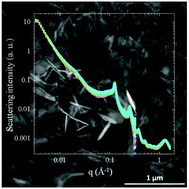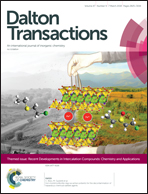In situ generation of layered single- or double-hydroxide inorganic platelets (LSH and LDH) assisted by bola amphiphiles†
Abstract
A novel preparation route for layered hydroxide based hybrid phases has been investigated combining the polyol route with the in situ generation of inorganic platelets, in the presence of an amphiphilic polymer as well as bola-amphiphiles. The polyol route consists of hydrolysis in an alcoholic medium containing acetate metal cations as precursor(s), to yield an LDH Zn2Al cation composition or LSH-Zn (layered single hydroxide). A bola amphiphile is described as hydrophobic polymer segment-telechelic-chains terminated by two anionic hydrophilic end groups, using volatile ammonium cations as counter ions. The impact of both process conditions as well as the chosen system with regard to the metal hydroxide framework on the morphology of the obtained hybrid phases is scrutinized by X-ray diffraction (XRD), small angle X-ray scattering (SAXS) and transmission electron microscopy (TEM), and compared to that of the corresponding physical mixture. For the ex situ approach, the diffusion of large cumbersome polymers or amphiphilic bolas between the inorganic platelets was found to be efficient, mostly driven by an anion exchange reaction between interleaved acetate anions and carboxylate functions of the molecular backbones, and keeping intact the inner sheet integrity through a topotactic process. In particular with LSH-Zn, a multi-stratified assembly has been observed combining an acetate pristine structure and a partly bola diffused structure, leading to a biphasic structure, aggregated and intercalated. To the best of our knowledge, observation of LSH-Zn single platelets has never been reported, making the combined process polyol/in situ an interesting new route to reach exfoliation. Indeed, it leads to the generation of either LSH or LDH platelets of lateral size ranging from 10 up to 200 nm. However, the platelets were found to be porous; it is considered as a drawback for barrier properties. It is our belief that such porosity may open new insights in “tectonic” architecture by intertwining 2D and 1D-type fillers. Rather counterintuitively, the ex situ approach based on a topotactic exchange reaction matches the in situ templating reaction in many cases as a function of the dispersion state regardless of the polymer or bolas as well as the platelet cation composition.

- This article is part of the themed collection: Recent Developments in Intercalation Compounds: Chemistry and Applications


 Please wait while we load your content...
Please wait while we load your content...